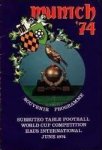
| Peter Upton's |
Subbuteo Tribute Website. |
|
The History of Competitive Table Soccer |
|
The 1970s - Subbuteo's glory years.
If you have arrived on this page from Part one of this history, then hopefully you will know that Peter Adolph launched the first Subbuteo Association in the late 1940s, and that this organisation was super-seeded by an independent European Table-Soccer Federation (ETF), and the affiliated English Table Soccer Association (ETSA). As we reached the 1970s, Waddingtons had taken over from Peter Adolph as the owners of Subbuteo Sports Games (SSG), and they were having a big marketing push into Europe. The game was bigger and more widespread than ever, and it was a great time to be a table football player. However, dark clouds were gathering....
With any big organisation, one of the dangers you are taught to watch for are "them and us" attitudes. Whether it is between branches and head-offices, or customers and suppliers... It's unhealthy, and ultimately destructive. In the ETSA newsletters of the mid-1970s, there is definitely a growing "them and us" situation with SSG.

To highlight the problems, it seems useful to start with SSGs big marketing event of the mid 1970s, the Munich World Series of 1974. Heavily promoted with flyers in box sets, and of course, the giant deluxe Munich World Series box set, this was the face of organised Subbuteo in this period. However, the Munich Box set with its novelty accessories, and excessive price was the complete opposite of what playing for the ETSA would have been about. It is very interesting to note, that although ETSA members were among the players and officials at the Munich World Series, the qualifying tournaments were not staged by them. Instead, they were organised by "National Association of Youth Clubs, Subbuteo stockists, and Educational Authorities etc." The two main sticking points between SSG and ETSA can be found in the SSG leaflet promoting these events.
1. Playing Figures. Subbuteo in the 1970s was, of course, all about "the OO scale three-dimensional figures". Subbuteo were not selling the flat figures by this time, and they were not permitted at the Munich World Cup. The ETSA happily allowed both types of figures, but the majority of top players were still using flats.
2. Age Range. Subbuteo's core market was always children. I guess nine to fourteen years old was the age group for most Subbuteo players. The competitive ETSA had a much older core, with a lot of university students. Their adult open tournaments were much better attended than their youth cups.
Into the Blue - An ETSA season in focus 1976-77.
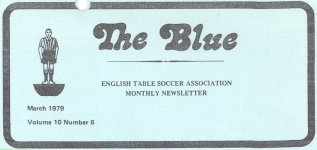
Focusing on one year seems a nice idea, but it was rather forced upon me because I only have access to about three years' worth of newsletters. I seem to have been lucky though. This season was a really successful one for the ETSA, with the first English win in the Europa Cup, and some well attended competitions. It also ended with a bang, with the fall-out with SSG, and a general crisis that followed on from this.
There are lots of issues dealt with in the Blue, and many will be familiar to anyone who has tried to run an organisation, or been roped into a committee post. There is lots of amusing little details, and items that drag on through the year. Here are a few topics to give a flavour of the period.
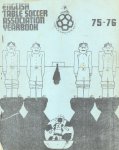
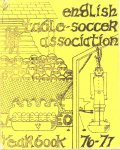
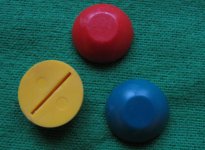

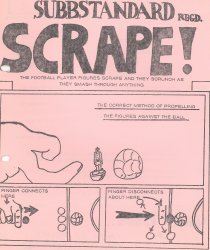
1977 - The parting of ways.
The September 1976 committee meeting not only hints at a zombie test, but notes that SSG "have recently had a boardroom shuffle". There was also a shuffle at the ETSA, with a new secretary being appointed. Almost as if the coming fall-out was inevitable, it is clear that the new secretary was much more hard-line anti-SSG than the old one.
When the committee met in February 1977 is was revealed that the ETSA secretary had been invited to a meeting with Subbuteo Sports Games "to be held in Holland.... involving representatives from all ETF-registered countries and probably others". The Blue records....
"(the secretary).... said he was reluctant to attend with any power of vote, but would rather simply record the proceedings and return with them for the committee and members to act upon. However, after discussion... especially in view of recent SSG activity in Europe, he should register a vote if absolutely necessary, but to do so only in the interests of the Association.... i.e. not support any motion that could in any way endanger the current aims and beliefs of the ETSA.
The meeting was held on 16th April 1977, at the Crest Hotel in Amsterdam. In attendance were three SSG employees (including director John Burbidge), plus representatives of the French and Dutch distributors. On the ETF side, there were two members of the Dutch organisation (NVMB), the secretary of "a rebel Dutch Assn", the ETSA rep, a member of the Austrian Assn, and one from the Italian Assn (who was probably also representing Italian distribution, as the two were closely linked). This was, perhaps, a disappointing turn-out when there were eleven countries in the ETF, but the expensive involved in visiting a Europe-wide meeting of a small amateur hobby makes this understandable.
For what was discussed, I only have the ETSA version of course. This was reported in the May 1977 issue of The Blue. The main source of information is the extremely amusing report from the ETSA secretary, which I'm very tempted to quote at length. It begins "There were a lot of free drinks, and everyone except the ETSA wore a suit". The ETSA secretary certainly casts himself in the role of the rebel, and an outsider. Everyone else is polite, and receptive to SSG, much to his annoyance.
The May 1977 Blue (the final issue for the season) was certainly a call-to-arms for the ETSA. The chairman had a whole page "proclaiming the anti-SSG campaign", and The Blue's editor has another full page robust rebuttal.
So what was SSG planning? The actual proposal seems lost amongst the defence of the ETSA. Basically though, SSG hoped to take over control of the European Table Soccer Federation, for promotional purposes. The May editorial stated "in order to increase their sales, SSG would like to reach more young people through the mediums of national and European Associations, and they are fully aware of how difficult it would be for them to do this successfully on their own". There is talk of a Subbuteo World organisation. SSG would provide the money, and support. They would use top players to market the game at Subbuteo events, and provide sponsorship. It was in SSG's interest to raise the profile of such events in the media, and they had a paid marketing team to do it. The downside to the proposal was a loss of independence, and the two big sticking points mentioned at the top of this page i.e. the associations would have to play with Subbuteo equipment (i.e. OO scale figures) to Subbuteo rules, and the junior events would inevitably get most of the publicity.
There has to be some sympathy for the ETSA position. The editorial perhaps summed it up the best - "we play using highly sensitive equipment, and a set of rules that demand high mental and technical skills. It would be a backward step to play to the simple SSG rules, and with their relatively clumsy equipment... Our game has never been about making x thousand pounds, it is certainly not going to be about helping someone else make x thousand pounds."
That was a negative way of looking at the offer though. The promotion of the game and an increase in players (especially young players) was clearly in the interest of both groups.
It is in the report of the April 1977 meeting that the "table-soccer" split crystallised. To the great surprise of the Subbuteo employees they discovered "the ETSA's notion that Table Soccer is a game in its own right which does not necessarily need any link, material or symbolic, with the word and institution Subbuteo." Again, this sounded reasonable, but imagine taking the same stance with other board games like Monopoly. Subbuteo also learnt that the ETSA were producing there own equipment. At first they threatened to stop it, to which the lovely quoted response is - "you can't, replied the ETSA a little doubtfully.... patents have run out, can't copyright design of a soccer pitch, goals, balls etc mumble". The Chairman of the ETSA later proposed that the Assn should change it's name to the English Mini or Micro-Football Assn. Sadly, no other name could ever overcome the powerful Subbuteo, and so the generic table soccer has continued to this day. He also proposed that "no member of the Assn be permitted to take part in games or appear in any capacity connected with table soccer without the consent of the Assn." A hard-line approach that would blow up in the following season.
One final thing to mention. In the Anti-SSG Blue, the Italian Association was singled out as being set up and run by the country's Subbuteo distributor. It was stated that this association was "the model of SSG's intentions for the rest of the world, and it's major function being to promote the company, and almost as an incidental detail, to provide competition for the players in its care". It undermined the criticism though, by adding "it has 1500 members and growing every day." Hold that thought in your head.
The ETSA Crisis 1977-78.
After their successful 1976-77 season, the next season started in a worrying manner for the ETSA. The first two Blues of the season were only one double-sided page, instead of the usual 6-8 pages. The first editorial is a big long moan at the apathy of the general members. Hardly any yearbook articles had been written, six Open Cups were held over the summer and only one set of results had come in. There were still problems with arranging the Europa Cup with only five weeks to go. On top of this, the Chairman and Treasurer had resigned. By the October issue, The Blue's editor had (unsurprisingly) resigned too. Yet on the playing front, everything seems to be normal. There were twenty-three players in the national leagues, and plenty at the regional championships.
However, the organisers' frustration at this turn of events, and the worries about SSG's plans boiled over in a couple of unpleasant events in the autumn of 1977. The top ETSA players had been playing in SSG promotional events throughout the 1970s. Prior to the SSG announcement in April 1977, the top two ETSA players had been part of a SSG "England Table Soccer team" who played an Italian team in Italy. This was apparently a big event, with TV coverage and a sizable crowd. Now there was a return match to be played at Wembley. The ETSA committee thought they should have the say on what was an English Table Soccer team, and they did not want their members to take part. The players though, felt they had an obligation to attend the second match. Add some slow and inadequate communication to the mix, and the end result was that the players concerned played, and were then asked to leave the ETSA. Worse than that, one was then refused permission to play in the SE Regional Cup (on a show of hands I believe) after actually travelling to the event. Perhaps the only saving grace was that The Blue remained pretty even-handed, publishing a letter from one of the affected players in the January 1978 issue.
The Europa Cup was staged in the midst of all this mayhem in November 1977 in Bracknell. Kurt Erb of Switzerland was the winner. In contrast to the previous couple of years, there was very little detail or match reports on this event in The Blue, which is a shame. A lack of media coverage was mentioned, in stark contrast to Subbuteo events. Also highlighted later was the fact that the Italian Entrants were "prevented from participating in the Europa Cup", although no further details on this were given.
By 1978 life in The Blue was settling down again. Discussions on how to advertise the Association and attract new members without Subbuteo's support were discussed. There is some black humour for neutrals, as the committee realise that the banned players were the current holders of both the league and the Challenge Cup. They would have to write and ask for them back. There was also concern at the "ailing relationship between SSG and the ETSA" Ailing? That's wonderful English understatement. It was proposed that a letter be sent to John Burbidge asking him to arrange a meeting. The anti-SSG committee members "probably to attend". Unsurprisingly, Mr Burbidge declined the invitation (although his reply gets misplaced before it can be presented to the committee).
The first Blue of the 1978-79 season had a more professional sheen, and the October AGM was described as "one of the most successful in our history in terms of control, attendance, and constructive debate". There was a full committee elected once more, described as having "a healthy progressive outlook". The minutes of the meeting show a lot of small, sensible rule changes, and a return to the job at hand, which was playing and enjoying table soccer. In addition, apology letters were sent to the banned members, and they were reinstated (whether they would want to come back is another matter). The new season had two national leagues with nineteen players in total. However, there was also a regional split for Division three, with another sixteen players competing in those leagues. The most pleasing thing for the ETSA must have been the huge entry to that year's English Youth Cup.
In the end, the ETSA, the ETF, and the Europa Cup all remained independent of Subbuteo Sports Games control. So what of Subbuteo's plans? Lets return to their quoted aim - "in order to increase their sales, SSG would like to reach more young people through the mediums of national and European Associations, and they are fully aware of how difficult it would be for them to do this successfully on their own".
With apathy and/or hostility from the ETSA and other associations, SSG unsurprisingly, did indeed successfully form their own national and European Associations... and we'll look at these on the next page of this history.
If you want more details from this period of Subbuteo/table soccer history, I'd suggest that you visit the website of author Terry Edge, who was one of the main movers and shakers from the period.
[ Main Page | Previous Page | Next Page ]